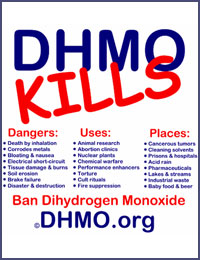
The dangers of DHMO, spelled out in alarming detail.
The Satire that Almost Became Law
In the eyes of many, the hallmark of good satire is subtlety. John Dryden, in his landmark 1693 treatise on satire, famously observed that the difference between mere mockery and true satire is "...[the] difference betwixt the slovenly Butchering of a Man, and the fineness of a stroke that separates the Head from the Body, and leaves it standing in its place." For most satire sites, being taken seriously is a significant coup -- a sign that, however outrageous the premise of a parody might be, it strikes close enough to home that it is almost plausible, at least to those who don't pay close attention. And there are few sites, if any, which have scored a coup on the scale of the Dihydrogen Monoxide Research Division (www.dhmo.org).
DHMO.org is an official-looking site that presents data on the perils of dihydrogen monoxide, which, as any chemistry student can tell you, is simply another name for water. The site lists the many dangers of this substance, all of which are genuine:
Dihydrogen monoxide is colorless, odorless, tasteless, and kills uncounted thousands of people every year...Most of these deaths are caused by accidental inhalation of DHMO, but the dangers of dihydrogen monoxide do not end there. Prolonged exposure to its solid form causes severe tissue damage. Symptoms of DHMO ingestion can include excessive sweating and urination, and possibly a bloated feeling, nausea, vomiting and body electrolyte imbalance. For those who have become dependent, DHMO withdrawal means certain death.
"My ulterior motives are fairly benevolent, I think," said DHMO.org author Tom Way, a computer science professor at Villanova University with a background in the television and film industry. "One of my goals is that one day, sites like DHMO.org will no longer be needed. Raising public awareness is the issue."

DHMO.org founder Tom Way is a faculty member at Villanova.
Many of course do not think carefully about what they read, and so in March 2004, the California municipality of Alisa Viejo very nearly passed a law banning foam containers at city-sponsored events because they contained DHMO. Although Alisa Viejo realized its mistake before passing legislation, it was not in time to prevent widespread national coverage of the incident (in the Associated Press and National Public Radio).
"If you're going to use the Internet, you have to use it in as efficient a manner as possible. It becomes even more important to crosscheck your facts: finding it in one resource isn't good enough," said Way. "My feeling is 'reader beware.'"
As Way notes, it is easy to create an official-looking site. In fact, the look of DHMO.org is deliberately simple. "If you look at the site the way it is now, it's by no means flashy. No one looks at it and goes, "Wow, this is amazing," which is just what you need, I think, if you're spoofing an agency," he explained.
While dihydrogen monoxide sites abound today -- a Google search on "DHMO" returns nearly 59,000 results -- DHMO.org was one of the first, created in 1997. Today, it is still going strong, offering translations in 14 languages and a wealth of information on DHMO. It also offers a complete disclaimer in a loosely protected press kit (the password is on the home page).

"I kind of look at it as an informational whoopee-cushion," said Way. "I make the whoopee-cushion, but I don't make them read it. I give it to other people -- if they choose to stick it on someone's chair...The site is used by teachers, librarians, etc. I'm trying to address the question of information literacy on the web -- just because it looks official and doesn't sound over the top doesn't mean you can trust it."
The broader question of information literacy is one that has been of concern to the scientific community for years. The National Science Board noted in its 2002 Science and Engineering Indicators that approximately 70 percent of Americans lack a clear understanding of the scientific process. An article in the June 2004 Scientific American examines possible reasons why a local government could fall for such parodies as DHMO.org. But with the increasing prevalence of the Internet as a source of news and information, the subject becomes more pressing and examples such as the DHMO.org scandal are valuable public lessons.
"Satire and parody can be valuable forms of social commentary," Way noted. "This goes back to a long tradition of people getting their news from places like the Tonight Show or the Daily Show -- sure, it's presented in a satirical way, but there's some basis to it. If Jon Stewart is joking about it, the story picks up a little importance, and you may actually pick up a newspaper to see what he's talking about."
Tom Way does not currently have plans to expand on DHMO.org, offering only periodic updates on media coverage. But he has renewed the domain for another four years, and anticipates that DHMO.org will continue to serve as a relevant satirical commentary on informational literacy (or the lack thereof) for some time to come.
"The media, to their credit, got it right this time," said Way, noting that the press caught on quickly to the parody in this instance. "It's not unusual for them to get things right. But it's not unusual for them to get things wrong, either."




